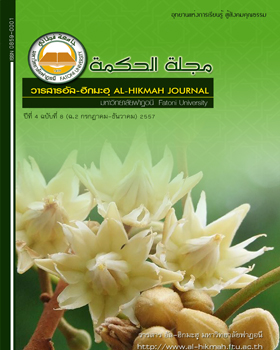constructing and testing the efficiency of English reading aloud exercises “Phonics Read Fast” in a primary 4 level at Budi school, Yaring, Pattani The Area Primary Education Pattani Zone 1
Keywords:
English Reading Aloud Exercises, Phonics Book Development, , the 80/80 Efficiency StandardAbstract
This research aimed at 1) constructing and testing the efficiency of English reading aloud exercises “Phonics Read Fast 1” and “Phonics Read Fast 2” in a primary 4 level at Budi school, Yaring, Pattani with the 80/80 standard, 2) comparing students’ learning achievement in English reading subject before and after employing the exercises and 3) investigating students’ opinions toward the exercises.
The sample consisted of one randomly selected class of 25 Prathom four students at primary level of Budi school, Yaring, Pattani. The English reading aloud exercises “Phonics Read Fast 1” and “Phonics Read Fast 2” were taught to the students based on their 14 lesson plan. After the completion of each lesson, the ongoing assessments were used to measure students’ learning achievement. The assignments were divided into three kinds; self- assessment by students, peer-assessment and teacher-assessment. Pretest and posttest were used to determine the students’ efficiency of the English reading aloud exercises. At the end of the experiments, questionnaire was administered to assess the students’ opinions toward the exercises. The obtained data were analyzed by means (), standard deviation and t-test.
The findings revealed that 1) the efficiency of the English reading aloud exercise “Phonics Read Fast 1” was 80.06/80.93 while the efficiency of the English reading aloud exercise “Phonics Read Fast 2” was 81.05/82.13, 2) the students’ learning achievement in reading after employing the exercises was significantly higher at the .01 level, and 3) the students’ opinions toward the English reading aloud exercises “Phonics Read Fast 1” and “Phonics Read Fast 2” were at a high level.
References
บุญชม ศรีสะอาด. 2545. การวิจัยเบื้องต้น. พิมพ์ครั้งที่ 7. กรุงเทพฯ : สุวีริยาสาส์น.
วาโร เพ็งสวัสดิ์. 2546. วิจัยในชั้นเรียน. กรุงเทพฯ: สุรีวิยาสาส์น.
อินทิรา ศรีประสิทธิ์. 2552. โครงการศึกษาการเสริมทักษะการอ่านภาษาอังกฤษด้วยวิธีการถอดรหัสตัวอักษรให้เป็นเสียงของนักเรียนในโรงเรียนเอกชน. รายงานการวิจัย 18 กันยายน2552 – มีนาคม 2553.
Kachru, B. B. (1985) Standards, codification and sociolinguistic realism: the English language in the outer circle. In R. Quirk and H.G. Widdowson (Eds), English in the world: Teaching and learning the language and literatures(pp. 11-30). Cambridge: Cambridge University Press.
Lurda, E. 2004. Non-native-speaker teachers and English as an International Language. International Journal of Applied Linguistics14/3: 314-323.
Shaywitz.S. 2003.Overcoming dyslexia: A new and complete science-based program for reading problems at any level. New York: Knopf.
Smith S. B., Simmons, D. C., &Kame'enui, E. J. 1998. Phonological awareness:Research bases. In D. C. Simmons & E. J. Kame'enui (eds.), What reading research tells us about children with diverse learning needs: Bases and basics. Mahwah, NJ : Lawrence Erlbaum Associates.



